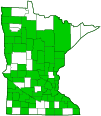golden northern bumble bee
(Bombus fervidus)
Conservation • Description • Habitat • Ecology • Distribution • Taxonomy
|
|
||||||||||||||
Description |
Golden northern bumble bee is a small, common, widespread, later season, bumble bee. It occurs across the United States and southern Canada, and in Mexico. In the U.S. it is mostly absent from the southeast and south-central states, but it occurs along the Appalachian Mountains as far south as northern Georgia. It is common but its numbers are declining. The range of this species has remained consistent, but the numbers have declined consistently since 1900. The cause of the decline is uncertain but likely includes habitat loss, pesticide use on agricultural fields, wildfire suppression, and prescribed burns in areas where few individuals exist. Golden northern bumble bees are found from mid-May through late September in grasslands, savannas, forest openings, agricultural areas, suburban developments, and roadsides. They nest mostly on the ground or above the surface in tall grass, in haystacks, or in abandoned mouse nests. Sometimes they nest below ground. The female (worker) bee is 7⁄16″ (10.5 to 11.0 mm) in length. The width of the abdomen is ⅛″ to ¼″ (4.0 to 6.5 mm). The body is mostly covered with long black and lemon-yellow hair. The hair on the head is entirely black, including a dense band of hairs on top of the head (vertex) at the rear. The back of the head and the face are black. The plate on the face (clypeus) is closely pitted (punctate) above and below with a broad, shiny, mostly unpitted area in the middle. The antennae have 12 segments consisting of a long basal segment (scape), a small connecting segment (pedicel), and a whip-like section (flagellum) with ten segments (flagellomeres). The scape is long, slightly more than half as long as all of the flagellomeres together. The first flagellomere is slightly shorter than the second and third combined. The tongue is long. The upper side of the thorax is densely covered with long, mostly yellow hair. The hair near the flap-like covering of the wing bases (tegulae) is black, with few if any yellow hairs. Between the wings there is a band of black hair that usually extends toward the rear in a shallow V shape. The sides of the thorax are covered in yellow hair. The abdomen has six segments and is densely covered with relatively long hair. The hair on the first through fourth segments is entirely yellow, on the fifth and sixth segments entirely black. The wings are deeply tinted smoky brown. The veins are brown to brownish-black. The legs are black and are covered with black hair. The queen is similar but larger, ¾″ to 13⁄16″ (19 to 21 mm) in length. The clypeus is doubly punctate, coarsely and deeply punctured with minute punctures in the spaces between. The unpitted area in the middle is narrower. The male (drone) is somewhat larger, 7⁄16″ to ¾″ (11 to 20 mm) in length. The middle area of the clypeus is finely and closely punctate. The antennae have 13 segments. The abdomen has 7 segments. The wings are lightly tinted with brick red to brownish-black veins. |
Size |
Male: 7⁄16″ to ¾″ (11 to 20 mm) Worker: 7⁄16″ (10.5 to 11 mm) Queen: ¾″ to 13⁄16″ (19 to 21 mm) |
Similar Species |
Habitat |
Grasslands, savannas, forest openings, agricultural areas, suburban developments, and roadsides. |
Ecology |
Season |
Mid-May through late September |
Behavior |
|
Life Cycle |
Nests are made on or above the ground in tall grass, haystacks, or abandoned mouse nests, and sometimes below ground. |
Larva Food |
|
Adult Food |
|
Distribution |
||
|
Sources |
|
| 1/7/2025 | ||
Occurrence |
||
Common |
||
Taxonomy |
|
Order |
Hymenoptera (Ants, Bees, Wasps, and Sawflies) |
Suborder |
Apocrita (Narrow-waisted Wasps, Ants, and Bees) |
Infraorder |
Aculeata (Ants, Bees, and Stinging Wasps) |
Superfamily |
Apoidea (Bees and Apoid Wasps) |
Epifamily |
|
Family |
Apidae (honey bees, bumble bees, and allies) |
Subfamily |
Apinae (honey, bumble, longhorn, orchid, and digger bees) |
Tribe |
Bombini |
Genus |
|
Subgenus |
Thoracobombus |
Some authors separate bumble bees and orchid bees into the subfamily Bombinae. NCBI follows this classification. Most authors follow Michener (2007) and include those groups in the subfamily Apinae with the honey bees. |
|
Subordinate Taxa |
|
|
|
Synonyms |
|
Apis alata Apis feruida Bombus consanguineus Bombus dumoucheli Bombus elatus Bremus fervidus Bombus fervidus dorsalis Bombus fervidus umbraticollis Bombus nevadensis aztecus Bombus sonomae |
|
Common Names |
|
golden northern bumble bee yellow bumble bee |
|
Glossary
Clypeus
On insects, a hardened plate on the face above the upper lip (labrum).
Flagellomere
A segment of the whip-like third section of an insect antenna (flagellum).
Pedicel
On plants: the stalk of a single flower in a cluster of flowers. On insects: the second segment of the antennae. On Hymenoptera and Araneae: the narrow stalk connecting the thorax to the abdomen: the preferred term is petiole.
Punctate
Dotted with pits (punctures), translucent sunken glands, or colored spots of pigment.
Scape
In plants: An erect, leafless stalk growing from the rootstock and supporting a flower or a flower cluster. In insects: The basal segment of the antenna.
Tegula
A small, hardened, plate, scale, or flap-like structure that overlaps the base of the forewing of insects in the orders Lepidoptera, Hymenoptera, Diptera, and Homoptera. Plural: tegulae.
Vertex
The upper surface of an insect’s head.
Visitor Photos |
||
Share your photo of this insect. |
||
This button not working for you? |
||
Dan W. Andree |
||
Colorful little bumble bee on thistle.... It was back in the summer of 2024. Cute little bumble bee that was aggressively feeding on that thistle blossom. |
||
 |
 |
|
 |
||
Babette Kis |
||
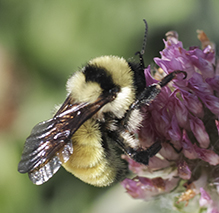 |
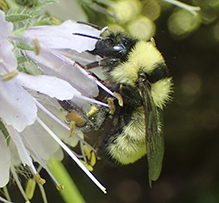 |
|
Bombus fervidus golden northern bumblebee |
||
One of my favorite bumblebees, and I've been actively looking for them most every day in spring thru fall for the last 7 years. |
I don't see a lot of them, and when I do, my pictures are often not the best. |
|
MinnesotaSeasons.com Photos |
||
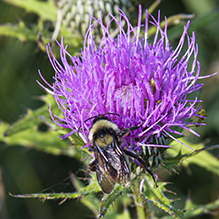 |
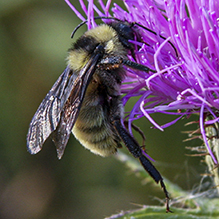 |
|
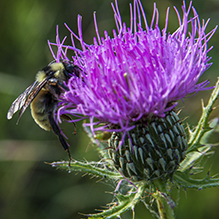 |

Visitor Videos |
||
Share your video of this insect. |
||
This button not working for you? |
||
|
Other Videos |
||
Golden Northern Bumblebee (Bombus fervidus) |
About
Aug 27, 2019 I have never seen this specific species of bumblebee before, so this was a treat! This was found at 5 Rivers Environmental Education Center in Delmar, NY |
Bombus fervidus queen on phlomis |
About
Jun 17, 2017 |
Bombus fervidus Mating |
About
May 5, 2014 Bombus fervidus mating on meadow blazing star (meadow liatris). |

Visitor Sightings |
||
Report a sighting of this insect. |
||
This button not working for you? |
||
Dan W. Andree |
Location: Norman Co. Mn. It was back in the summer of 2024. Cute little bumble bee that was aggressively feeding on that thistle blossom. |
 |
MinnesotaSeasons.com Sightings |
||

Created: 5/12/2023 Last Updated: © MinnesotaSeasons.com. All rights reserved. |
